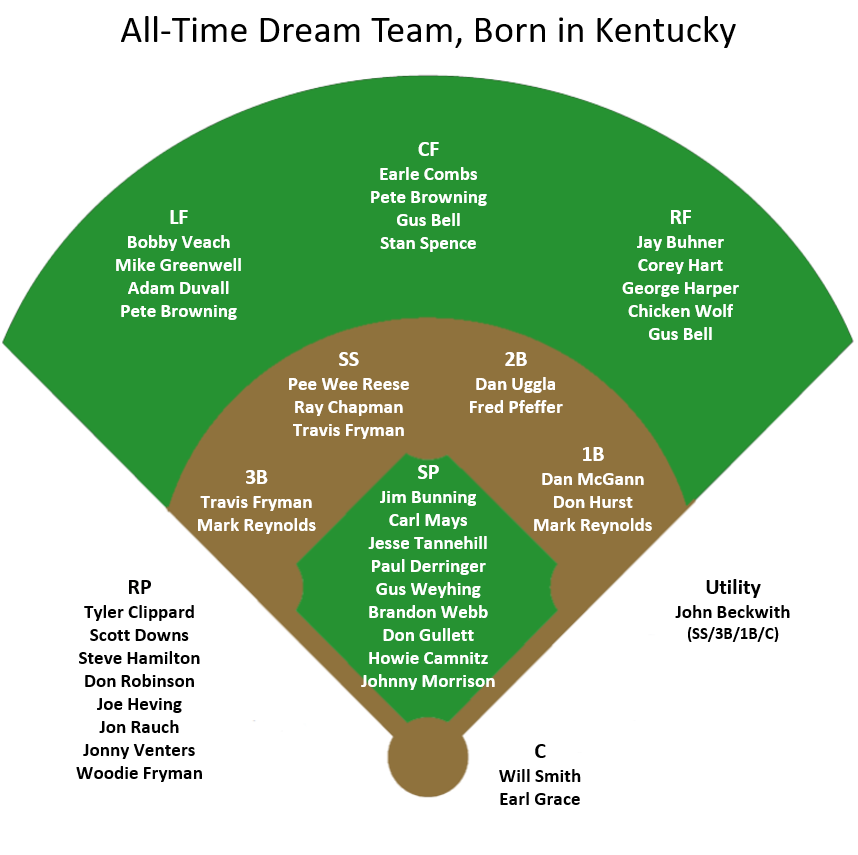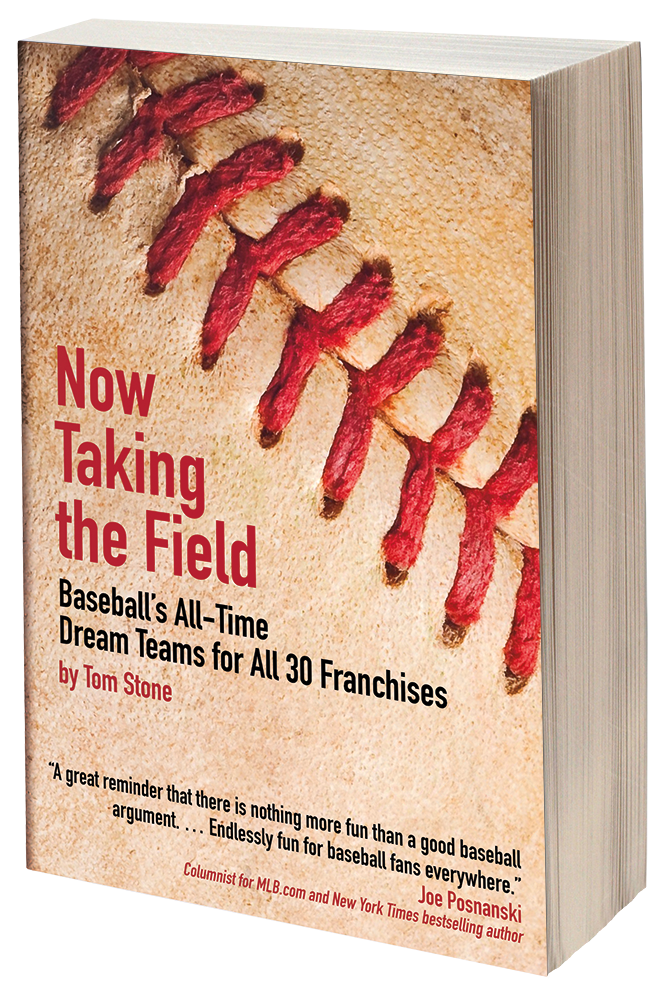Kentucky's Baseball All-Time Dream Team
What would a dream team roster look like for major league players born in Kentucky?
Issue #92
This is the seventh article in a new series I’ve started where I’m creating all-time dream teams for players born in each of the fifty US states. I’ll be publishing each write-up on the anniversary date that the particular state joined the union. So far I’ve covered Maryland, Louisiana, Minnesota, South Carolina, Rhode Island, and Wisconsin.
Next up are two in one day, the neighboring states of Kentucky and Tennessee. Kentucky became the 15th state to join the union in 1792, splitting from Virginia in the process (according to Wikipedia). Further south, Tennessee would join four years later on the same June 1st date, but I’ll cover their all-time dream in my next article.
[Note: I’m creating these all-time dream teams based on the birthplace data available at baseball-reference.com. I realize this might mean some players will appear for a state’s all-time dream that seems odd, e.g., a player who was born in one state but lived there only briefly, while then spending most of his youth, or especially critical years playing baseball in high school in another state. So I’m giving that caveat to this 50-article project at the outset.]
Here is the all-time dream team I came up with for players born in Kentucky:
Like the other US State dream teams I’ve created so far, this one has a few Hall of Famers and other stars, but also some positions that are relatively lacking. The Hall of Famers include SS Pee Wee Reese, CF Earle Combs, and SP Jim Bunning. Several additional outfielders are also solid stars on this team: 19th century star Pete Browning, deadball-era star Bobby Veach, 1950s slugger Gus Bell, and 1990s star Jay Buhner.
I hadn’t realized that both Carl Mays and Ray Chapman were born less than a year apart, and less than 200 miles apart, both hailing from Kentucky. They are of course forever connected by August 16, 1920, when Chapman tragically died after being hit in the head by a pitch thrown by Mays.
There weren’t a lot of catcher candidates for this dream team roster, but the Dodgers’ Will Smith is still young so hopefully his career continues to progress. 1B also was a relatively weak spot, with Dan McGann (1896-1908) and Don Hurst (1928-1934) being the top options.
Some readers might not be familiar with John Beckwith, who was a star in the Negro Leagues and played both of those positions but even more often at SS and 3B. I’ve included him in a utility spot on this roster, as according to the statistics we have at baseball-reference.com he slashed .349/.403/.583 with a 161 OPS+ in 2,009 plate appearances.
I went with Dan Uggla as the top 2B over old-timer Fred Pfeffer. Uggla hit 30+ HR in five consecutive seasons, but also struck out 149+ times in seven consecutive seasons. He doesn’t get the prize for the most one-track, HR-or-strikeout minded guy on this roster though. That goes to Mark Reynolds, who split his time between 1B and 3B and belted 30+ HR four times with a high of 44 in 2009, but also had 150+ strikeouts in seven seasons, including three seasons with over 200 Ks each.
Eagle-eyed readers might also notice the name Chicken Wolf, listed in RF, on the above dream team roster. William Van Winkle Wolf, aka Jimmy, played from 1882-1892, mostly for Louisville of the American Association (considered a Major League during that time). His statistics read like many good players of that era, with several seasons of double-digit triples, 40+ SB, and a lifetime .290 average. Over his career he played at least a few games at every position on the diamond, but the vast majority were in RF.
And the nickname “Chicken”? According to his bio at the SABR BioProject, the nickname “was allegedly given to him by his boyhood friend and major league teammate, Pete Browning. The story goes that when Wolf and Browning were teenagers they were both members of the then semi-pro Louisville Eclipse team. Their manager instructed the team to eat lightly before a certain game, but Wolf surrendered to his appetite and stuffed himself on stewed chicken. He then played poorly in the game, committing several errors. Browning made a connection between the chicken and the lackluster play and hung the nickname ‘Chicken’ on him. The name caught on with his teammates and the local press.”
Starting lineups for this all-time dream team could look like this:
Against RHP:
Earle Combs CF (L)
Pete Browning DH (R)
Bobby Veach LF (L)
Jay Buhner RF (R)
Will Smith C (R)
John Beckwith 1B (R) / Don Hurst 1B (L)
Travis Fryman 3B (R)
Dan Uggla 2B (R)
Pee Wee Reese SS (R)
Against LHP:
Pete Browning DH (R)
Earle Combs CF (L)
Bobby Veach LF (L)
Jay Buhner RF (R)
Will Smith C (R)
John Beckwith 1B (R) / Dan McGann 1B (S)
Travis Fryman 3B (R)
Fred Pfeffer 2B (R)
Pee Wee Reese SS (R)
I flipped Earle Combs and Pete Browning in the 1-2 spots depending on RHP/LHP, though lefty-hitting Mike Greenwell probably deserves some DH at-bats against RHP as well. Compared to some other dream teams in my US States series, this Kentucky roster doesn’t have a lot of power, though Bobby Veach had five seasons with 100+ RBI, and Jay Buhner had three consecutive 40+ HR, 100+ RBI seasons.
At 1B I went with mix of John Beckwith and Don Hurst against RHP, and Beckwith and Dan McGann against LHP (McGann was a switch-hitter but hit LHP better.) Mark Reynolds could also be in the mix there, or occasionally relieve Travis Fryman at 3B. There was a natural platoon at 2B, where Uggla brings his aforementioned power, and Pfeffer had nine consecutive seasons of 25+ SB, including four of 40+.
As for the pitchers, the starting rotation is led by Hall of Famer Jim Bunning, who was an All-Star in seven seasons and mostly played for the Phillies and Tigers. He posted 200+ strikeouts six times, leading his league in 1959, 1960, and 1967. The second SP spot I think needs to go to Mays, who won 20+ games five times, including a 26-11 record in 1920, and a 27-9 mark in 1921. His career ERA of 2.92 translates to a solid 120 ERA+.
After those two you could debate how to rank the next several SP. Jesse Tannehill (1894-1911) won 20+ games six times, and led the NL with a 2.18 ERA in 1901. Paul Derringer (1931-45) was a six-time All-Star and won 20+ games four times. And old-timer Gus Weyhing (1887-1901) started out strong by notching 23+ wins in each of first seven seasons.
You could also make a case for some of the others I included to be in that top five, such as Brandon Webb who was an All-Star from 2006-2008, winning the Cy Young Award in 2006 and coming in second in the vote the next two years, before injuries led to an early retirement. Don Gullet, Howie Camnitz, and Johnny Morrison also earned spots on this roster, with two Cleveland Indians pitchers, Len Barker and Paul Byrd, deserving at least honorable mention.
I didn’t find any dominating closer candidates for this Kentucky Dream Team roster, but there were many relievers worth including, starting with the much-travelled Tyler Clippard who has played for 10 different major league teams across 16 seasons. After 807 major league appearances in which he compiled a 3.16 ERA and 131 ERA+, he is 38 years old and currently a free agent, so it remains to be seen if he’ll pitch in the majors again.
How to rank the seven other relievers that I included could be debated, including Woodie Fryman who I included as a mixed starter/reliever. Fryman had seven seasons with double-digit wins, starting 322 total games over his 18-year career, while entering from the bullpen in another 305 games.
All data is from Baseball-Reference.com, and also their subscription service Stathead.com. If you are a big sports fan, be sure to check out the latest features at Stathead and the Sports Reference family of sites. The state map, flag, flower, and bird images are from Wikipedia.
Did you know? I wrote a book with the same title as this Substack newsletter / blog: Now Taking the Field: Baseball’s All-Time Dream Teams for All 30 Franchises. It was published in early 2019, by ACTA Sports, the publisher of the annual Bill James Handbook and other popular titles. You can learn more about it at www.NowTakingTheField.com, or buy directly at Amazon and other booksellers.






